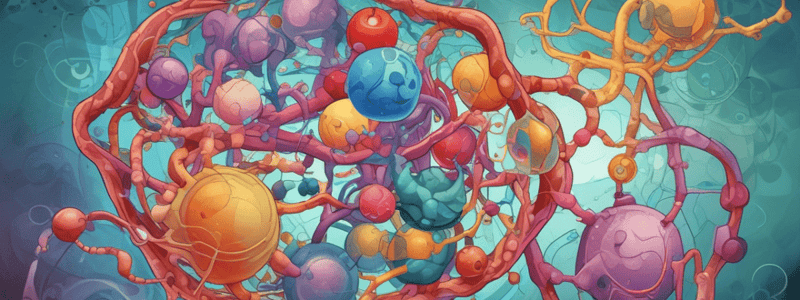Podcast
Questions and Answers
What is the role of nucleic acids in the cell?
What is the role of nucleic acids in the cell?
- Provide structural support to the cell
- Store and transmit genetic information (correct)
- Act as enzymes and hormones
- Regulate cell adhesion and neuronal receptors
What is the process by which polymers are formed?
What is the process by which polymers are formed?
- Condensation reaction
- Dehydration synthesis (correct)
- Hydrolysis
- Fermentation
What is the function of phospholipids in the cell?
What is the function of phospholipids in the cell?
- To store energy
- To regulate gene expression
- To form the membrane of cells (correct)
- To provide structural support to the cell
What is the monomer of carbohydrates?
What is the monomer of carbohydrates?
What is the process by which monomers are recovered from polymers?
What is the process by which monomers are recovered from polymers?
What is the type of protein that provides structural support to the cell?
What is the type of protein that provides structural support to the cell?
What is the process called when a polymer is broken down into monomers with the addition of a water molecule?
What is the process called when a polymer is broken down into monomers with the addition of a water molecule?
What is the primary function of ATP in the cell?
What is the primary function of ATP in the cell?
What is the main difference between DNA and RNA molecules?
What is the main difference between DNA and RNA molecules?
What is the monomer of nucleic acids?
What is the monomer of nucleic acids?
What is the process by which polymers are formed?
What is the process by which polymers are formed?
What type of carbohydrates is glycogen an example of?
What type of carbohydrates is glycogen an example of?
What type of protein is human growth hormone?
What type of protein is human growth hormone?
What is the main constituent of cell walls?
What is the main constituent of cell walls?
What is the purpose of glycogen in animal tissues?
What is the purpose of glycogen in animal tissues?
What type of molecules are DNA and RNA?
What type of molecules are DNA and RNA?
What is the process by which glucose is stored in animal tissues?
What is the process by which glucose is stored in animal tissues?
What is the ratio of hydrogen to oxygen atoms in a carbohydrate molecule?
What is the ratio of hydrogen to oxygen atoms in a carbohydrate molecule?
What type of reaction links amino acid monomers to form polypeptides?
What type of reaction links amino acid monomers to form polypeptides?
What is the typical length of a peptide?
What is the typical length of a peptide?
What is the fate of amino acids broken down in the body?
What is the fate of amino acids broken down in the body?
What is the role of post-translational modifications in proteins?
What is the role of post-translational modifications in proteins?
What type of carbohydrates is glycogen an example of?
What type of carbohydrates is glycogen an example of?
What is the role of nucleic acids in the cell?
What is the role of nucleic acids in the cell?
What is the primary function of triglycerides in the cell?
What is the primary function of triglycerides in the cell?
What is the characteristic of phospholipids that makes them ideal for forming cell membranes?
What is the characteristic of phospholipids that makes them ideal for forming cell membranes?
What is the role of cholesterol in the cell membrane?
What is the role of cholesterol in the cell membrane?
What type of carbohydrate is a long-term energy storage molecule in the cell?
What type of carbohydrate is a long-term energy storage molecule in the cell?
What is the monomer of nucleic acids?
What is the monomer of nucleic acids?
What is the characteristic of lipids that makes them non-polar molecules?
What is the characteristic of lipids that makes them non-polar molecules?
Flashcards
Nucleic Acid Role
Nucleic Acid Role
Store and transmit genetic information within the cell.
Dehydration Synthesis
Dehydration Synthesis
The process that forms polymers by removing a water molecule.
Phospholipid Function
Phospholipid Function
Forms the cell membrane.
Monosaccharide
Monosaccharide
The monomer of carbohydrates.
Signup and view all the flashcards
Hydrolysis
Hydrolysis
The process by which polymers are broken down into monomers via the addition of water.
Signup and view all the flashcards
Fibrous Proteins
Fibrous Proteins
Proteins that provide structural support to the cell.
Signup and view all the flashcards
ATP Function
ATP Function
Energy currency of the cell, providing readily available energy for cellular processes.
Signup and view all the flashcards
DNA vs. RNA
DNA vs. RNA
DNA is double-stranded, containing deoxyribose. RNA is single-stranded, containing ribose.
Signup and view all the flashcards
Nucleotide
Nucleotide
The monomer of nucleic acids.
Signup and view all the flashcards
Polysaccharide
Polysaccharide
A complex carbohydrate composed of many monosaccharides.
Signup and view all the flashcards
Globular Proteins
Globular Proteins
Category of proteins that includes hormones
Signup and view all the flashcards
Cellulose
Cellulose
The main constituent of plant cell walls, providing structural support.
Signup and view all the flashcards
Glycogen Purpose
Glycogen Purpose
To store excess glucose in animal tissues for later use.
Signup and view all the flashcards
DNA/RNA type
DNA/RNA type
DNA and RNA, essential for storing and transmitting genetic information.
Signup and view all the flashcards
Glycogenesis
Glycogenesis
The process by which glucose is stored in animal tissues as glycogen.
Signup and view all the flashcards
Carbohydrate H:O Ratio
Carbohydrate H:O Ratio
The ratio is 2:1; for every 1 oxygen, there are 2 hydrogen atoms.
Signup and view all the flashcards
Amino Acid Linking
Amino Acid Linking
Dehydration reactions link amino acids to form peptide bonds which create polypeptides.
Signup and view all the flashcards
Peptide Length
Peptide Length
Typically spans from 2 to 50 amino acids.
Signup and view all the flashcards
Amino Acid Fate
Amino Acid Fate
Enter the urea cycle and Krebs cycle for excretion or energy production.
Signup and view all the flashcards
PTM Role
PTM Role
Change the structure and function of the coded protein.
Signup and view all the flashcards
Triglyceride Function
Triglyceride Function
To serve as a long-term energy storage molecule in the cell.
Signup and view all the flashcards
Phospholipid characteristic
Phospholipid characteristic
Their amphipathic nature allows them to form a bilayer structure
Signup and view all the flashcards
Cholesterol Role
Cholesterol Role
To maintain membrane fluidity, especially at lower temperatures.
Signup and view all the flashcards
Long term Energy Source
Long term Energy Source
Glycogen.
Signup and view all the flashcards
Nucleotide
Nucleotide
Monomer that makes up the nucleic acids.
Signup and view all the flashcards
Lipid Property
Lipid Property
Their hydrophobic nature.
Signup and view all the flashcards



